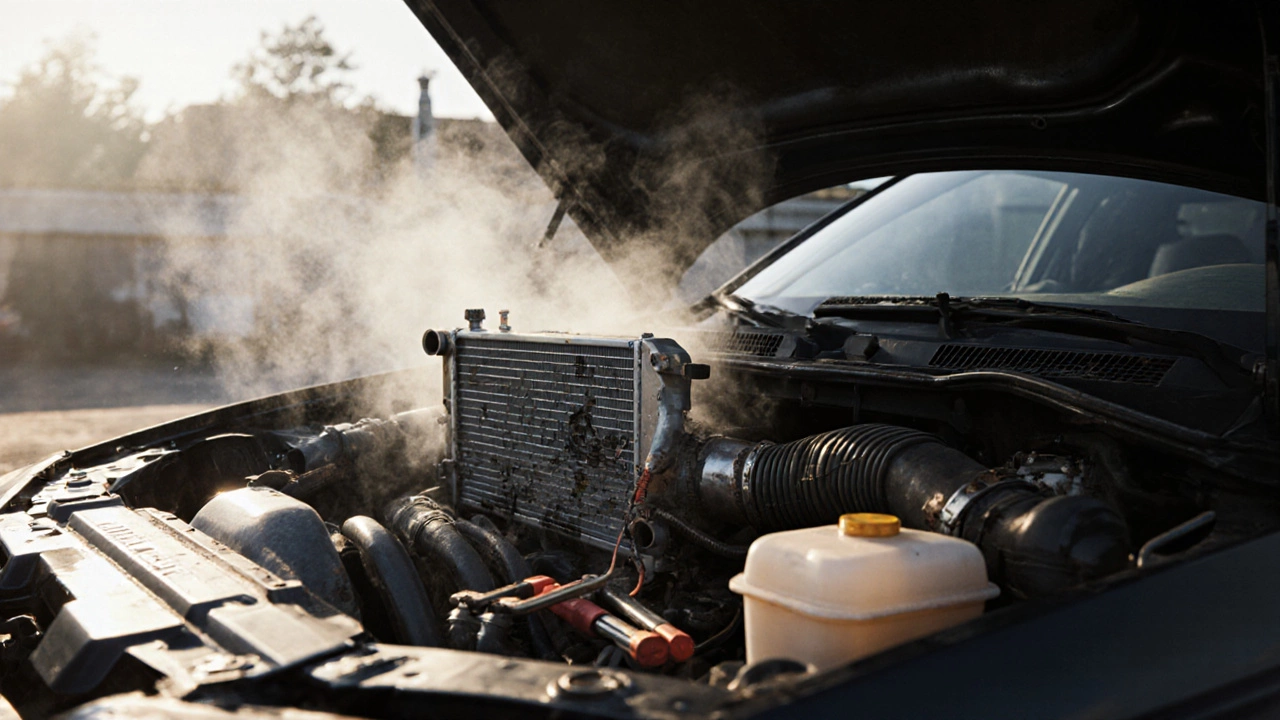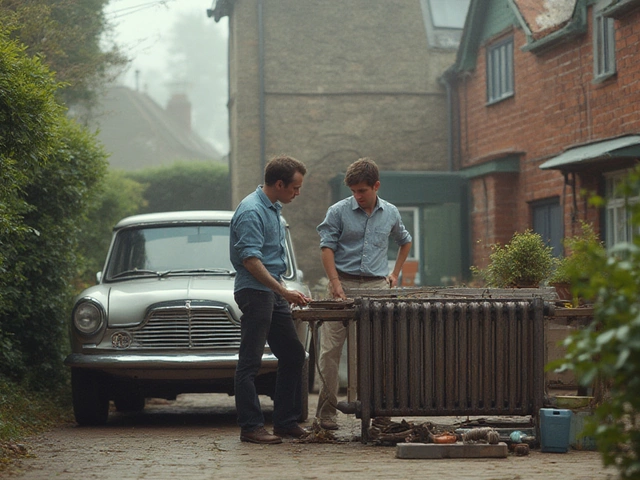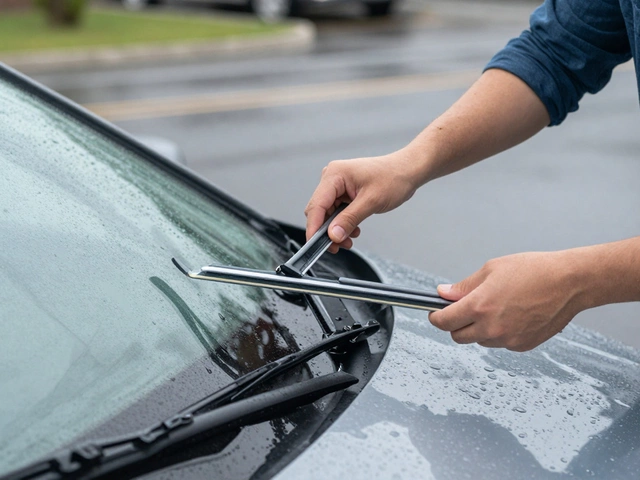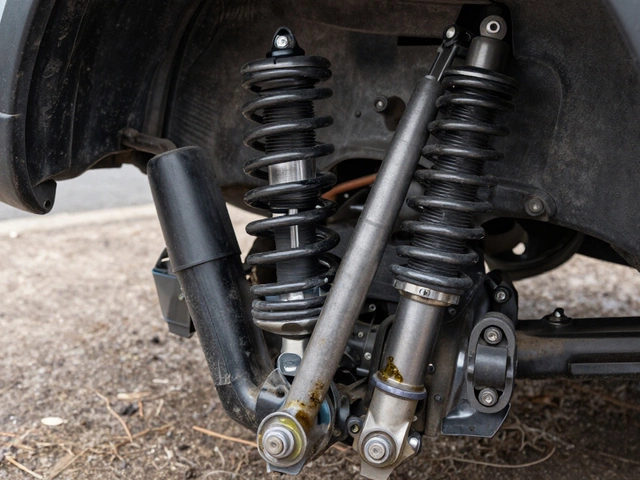Radiator Replacement Cost Calculator
Calculate Your Radiator Replacement Cost
Get an estimate based on your car type, location, and additional parts
Estimated Cost
Total estimate will appear here after calculation
How the Estimate Works
Our calculator uses industry-standard pricing from the UK automotive market:
- Base Parts Cost: £100-£500
- Labor Cost: £150-£500
- Location Adjustment: +15-20% (London/South East)
If your car is overheating, steam is coming from under the hood, or you keep needing to top up coolant, chances are your radiator is failing. Replacing it isn’t a simple fix like changing a light bulb, but it’s one of the most common repairs drivers face-especially in older cars or after an accident. So how much does it actually cost to replace a radiator on a car? The answer isn’t one number. It depends on your car model, where you live, whether you go to a garage or do it yourself, and if other parts need replacing at the same time.
What’s Inside a Car Radiator?
A radiator isn’t just a metal tank with coolant in it. It’s part of a system that includes the radiator cap, hoses, thermostat, water pump, cooling fan, and sensors. The radiator itself is usually made of aluminum and plastic end tanks, with thin metal fins inside to help dissipate heat. Over time, corrosion, debris, or physical damage (like hitting a curb or a stone on the highway) can crack the plastic tanks or clog the internal passages. When that happens, coolant leaks out, the engine overheats, and you’re stuck.
Most radiators last between 8 and 12 years, but in places with harsh winters or salty roads-like Manchester-it’s not unusual to see them fail after 6 years. If your car is older than 10 years and you’re seeing coolant stains under the front bumper, don’t ignore it. A small leak now can turn into a blown head gasket or warped cylinder head later. That’s a repair that costs thousands, not hundreds.
Cost Breakdown: Parts vs Labor
Replacing a radiator breaks down into two big chunks: parts and labor. On average, parts alone cost between £100 and £350. Labor adds another £150 to £400. That means your total bill could be anywhere from £250 to £750.
Why such a big range? It comes down to your car. A basic Ford Focus or Vauxhall Astra from the 2010s will have a straightforward radiator swap. The part might cost £120, and labor takes about 2 hours. Total? Around £300 to £400.
But if you drive a BMW 3 Series, Audi A4, or a luxury SUV like a Range Rover, things get more complicated. These cars often have electric cooling fans mounted directly to the radiator, multiple coolant lines, and sensors that need recalibration after replacement. The radiator part alone can cost £300 to £500. Labor? 4 to 6 hours. Total? £600 to £900.
Here’s a quick look at typical costs by car type:
| Car Type | Parts Cost | Labor Cost | Total Estimate |
|---|---|---|---|
| Small Hatchback (e.g., Ford Fiesta, VW Polo) | £80-£150 | £150-£200 | £230-£350 |
| Family Sedan (e.g., Toyota Corolla, Honda Civic) | £120-£200 | £200-£280 | £320-£480 |
| Mid-Range SUV (e.g., Nissan Qashqai, Hyundai Tucson) | £150-£280 | £250-£350 | £400-£630 |
| Luxury/Performance (e.g., BMW 3 Series, Audi A4) | £300-£500 | £350-£500 | £650-£900 |
| Classic/Classic Car (e.g., MG MGB, Ford Cortina) | £200-£400 (custom or reproduction) | £300-£500 (specialist labor) | £500-£900 |
Keep in mind: these are UK averages as of late 2025. Prices in London or the South East can be 15-20% higher than in Manchester, Leeds, or Glasgow. Independent garages usually charge less than dealerships-but make sure they use OEM or high-quality aftermarket parts. A £60 radiator from a no-name brand might leak again in 6 months.
What Else Might Need Replacing?
When a radiator fails, it often drags other parts down with it. That’s why you should never just replace the radiator and call it done. Here’s what mechanics usually check-or recommend replacing-at the same time:
- Radiator hoses: Rubber hoses harden and crack over time. If they’re 5+ years old, replace them. They cost £15-£40 each, and labor adds £50-£80.
- Thermostat: A stuck thermostat is a common cause of overheating. Replacing it while the cooling system is open saves labor. Costs £40-£100 for the part, plus £80-£120 labor.
- Coolant: You’ll need 5-8 liters of new coolant. OEM-spec antifreeze costs £15-£25 per liter. Mixing it yourself? Save £30-£50.
- Water pump: If your car has a timing belt-driven water pump, and the belt is due for replacement, do both jobs together. The pump alone costs £100-£250, but labor is high because you’re already dismantling the front of the engine.
- Cap and sensors: A faulty radiator cap can cause pressure loss and overheating. Sensors (like the coolant temperature sensor) may be faulty too. They’re cheap-£10-£40-but easy to miss.
Many garages offer a “cooling system service pack” that includes the radiator, hoses, thermostat, and coolant. It costs £50-£100 more than just the radiator-but it’s smarter. You’re not paying twice for labor, and you’re preventing a repeat failure.

Can You Do It Yourself?
Yes, you can replace a radiator yourself-if you’re handy, have the right tools, and your car isn’t too complex. For a basic model like a Vauxhall Corsa or Toyota Yaris, it’s a weekend project. You’ll need:
- New radiator
- New radiator hoses (recommended)
- New thermostat (recommended)
- New coolant (at least 5 liters)
- Socket set, wrenches, drain pan
- Funnel and gloves
- Owner’s manual (for bleeding procedures)
Time required: 3 to 6 hours. Cost: £120-£300 total, depending on parts.
But here’s the catch: if you don’t bleed the air out of the cooling system properly, you’ll get air pockets. That causes overheating-even with a brand-new radiator. Many DIYers learn this the hard way after driving for 20 minutes and seeing the temperature needle spike.
Some cars have tricky bleed points or require special tools to reset the cooling system after refill. BMWs, for example, often need a diagnostic tool to activate the coolant pump and remove air. If you don’t have access to one, you’re better off letting a pro handle it.
Where to Buy the Right Radiator
Not all radiators are made equal. You’ve got three main options:
- OEM (Original Equipment Manufacturer): Made by the same company that supplied the factory. Best fit, best longevity. Costs the most-up to £500 for a luxury car.
- Aftermarket (quality brand): Brands like Behr, Valeo, or Denso make parts that meet or exceed OEM specs. Reliable and cheaper. Look for these if you want balance.
- Universal or cheap aftermarket: Sold at bargain prices on Amazon or eBay. Often made with thinner metal, weaker plastic, or incorrect fittings. Avoid these. They’re a false economy.
Stick to trusted suppliers like Halfords, Euro Car Parts, or directly from the manufacturer’s website. If the price seems too good to be true, it probably is.
Signs You Need a New Radiator (Not Just a Leak)
Not every coolant leak means the radiator needs replacing. Sometimes it’s just a loose hose clamp or a cracked cap. Here’s how to tell the difference:
- Leak from the radiator itself: Wetness or white residue on the radiator fins, end tanks, or seams? That’s the radiator.
- Green, orange, or pink puddles under the front of the car: Coolant leaks usually pool directly under the engine bay. If it’s near the wheels, it’s probably a brake or transmission issue.
- Engine overheating even after refilling coolant: If you top up coolant and it’s gone again in a week, something’s failing.
- Sludge or rust in the coolant: Drain a bit into a clear bottle. If it looks muddy or has flakes, the radiator or engine block is corroding.
- Heater doesn’t blow hot air: The heater core runs off the same coolant. If it’s cold, the system isn’t circulating properly.
If you’re unsure, take your car to a garage for a pressure test. Most charge £20-£40 for this, but it saves you from replacing the wrong part.

How to Save Money on Radiator Replacement
There’s no magic trick, but you can cut costs without cutting corners:
- Get quotes from 3 local garages: Prices vary wildly. One in Manchester might charge £380, another £520 for the same job.
- Buy the radiator yourself: Order it online from a trusted supplier and bring it to the garage. Many will install it for labor only.
- Combine with other services: If your timing belt or water pump is due, do it all at once. You’ll save on labor.
- Check for warranty: Some aftermarket radiators come with 2-year warranties. Keep the receipt.
- Don’t delay: A small leak today becomes a £2,000 engine rebuild tomorrow.
Remember: a radiator isn’t something you fix with duct tape. It’s a critical safety component. Driving with a bad radiator risks engine seizure, which leaves you stranded-and out thousands.
What Happens If You Don’t Replace It?
Ignoring a bad radiator doesn’t just mean a hot engine. It leads to:
- Warped cylinder heads
- Blown head gasket
- Seized pistons
- Cracked engine block
Each of these costs £1,500 to £5,000 to fix. In some cases, it’s cheaper to scrap the car. A £400 radiator replacement is a bargain compared to that.
How long does a radiator replacement take?
For most standard cars, it takes 2 to 4 hours. Luxury or complex models with electric fans or tight engine bays can take 5 to 7 hours. DIYers should allow 6 to 8 hours, especially if they’re doing it for the first time.
Can a radiator be repaired instead of replaced?
Sometimes, yes-if it’s a small leak in a metal tube and you catch it early. Some shops offer radiator repair with epoxy or solder, but this is only a temporary fix. Plastic end tanks cannot be repaired. For any car driven regularly, replacement is the only reliable solution.
Do I need to flush the cooling system when replacing the radiator?
Absolutely. Old coolant contains rust, debris, and contaminants that can clog the new radiator. A full flush removes all old fluid and cleans the engine block, hoses, and heater core. Skipping this step is why many new radiators fail within months.
Is it safe to drive with a leaking radiator?
No. Even a slow leak can cause the engine to overheat in minutes, especially on the motorway. Overheating can warp metal parts and destroy the engine. If you notice coolant loss, stop driving and get it checked immediately.
How often should I replace my radiator?
There’s no fixed schedule, but most radiators last 8 to 12 years. In areas with salted roads or extreme temperatures, expect 6 to 8 years. Inspect it every 2 years for cracks, leaks, or discolored coolant. Replace it before it fails.
Final Thoughts
Replacing a radiator isn’t cheap, but it’s one of the most cost-effective repairs you can make. For under £500 on most cars, you’re protecting an engine that could cost ten times more to replace. Don’t wait until your car dies on the side of the road. If you’re seeing signs of trouble-coolant loss, overheating, strange smells-act fast. Get a quote, compare options, and don’t let pride or budget fears cost you your car.







